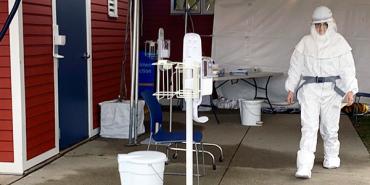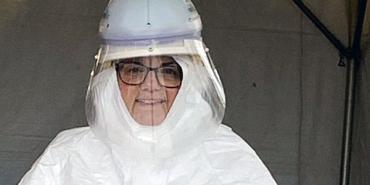Connecticut closed its schools March 13 in an effort to slow the spread of COVID-19. The school closures meant school nurses like Toni Pederson would be out of work for at least several weeks. As fate would have it, however, the state established COVID-19 test sites at local hospitals, and nurses like Pederson were needed on the frontlines.
“I went to school on Monday so parents could pick up their children’s medications, and my employer announced there would be a testing facility at Lawrence + Memorial Hospital, and they asked if we could staff the facility,” says Pederson.
Pederson and other school nurses employed by the Visiting Nurse Association of Southern Connecticut and represented by VNA of Southeastern CT Union Local 5119/AFT Connecticut were hired to perform COVID-19 testing at the drive-through testing center at Lawrence + Memorial in New London.
In fact, members of the local negotiated with the VNA to get the nurses assigned to this role during the crisis. “It is a great example of solution-driven unionism and shows how collective bargaining empowers members to apply our faith, strength and willingness to work together—the union way—to get everyone through this,” says Ann Ryan, president of Local 5119.
Before they could test patients, the nurses were trained to put on and take off their protective gear and to perform proper swab tests. When they have to come in contact with patients, the nurses are covered from head to toe in a disposable protective suit. They also wear respirator masks and plastic facemasks. At the site, there are usually two nurses on each shift responsible for testing patients who have been referred by a doctor and have an appointment to be tested.
“The clean nurse greets the patient in cars, and the collector nurse wears the suit,” says Pederson. The nurses also hand sanitize and double glove with each new patient.
Pederson says patients get out of the car and go into a tent to get the test—a nasopharyngeal swab test that takes about five seconds. The swab is secured and taken by a lab tech. Most patients get the results in five days, but healthcare workers can get their results in a day.
The nurses can work one of two shifts—morning or afternoon. Pederson works three or four days a week in the afternoons. The drive-through site is getting busier each day, and the patients are more diverse, says Pederson. “The first week, we saw mostly elderly patients and patients in their 40s and up. This week, I tested a 17-month old.”
Like many healthcare workers, nurses at the drive-through sites are experiencing some protective equipment shortages. “We have to be conservative and very careful,” says Pederson. “We are not wearing the yellow gown anymore, and we have to re-evaluate what’s more important to cover. The bunny suit is still disposable, but the biggest change is that I have a face shield that is mine for the duration. I sanitize it daily.”
The testing site is a well-oiled machine, and being tested helps to relieve the anxiety that some people are feeling. “They are scared. You can see it in their faces,” says Pederson. “We’re all anxious.”
She worries about possibly spreading the virus, but likes that she is actively involved. “It’s always in the back of mind when I think about my family; and while I’m glad to be able to do this, I hope the virus is defeated soon so the facility and testing won’t be needed.”
Having been a registered nurse for 35 years and a school nurse for the past 15 years, Pederson says the lesson the public can learn boils down to washing your hands, and social distancing will benefit everyone. People can also help others, she says, by “staying home.”
[Adrienne Coles]


